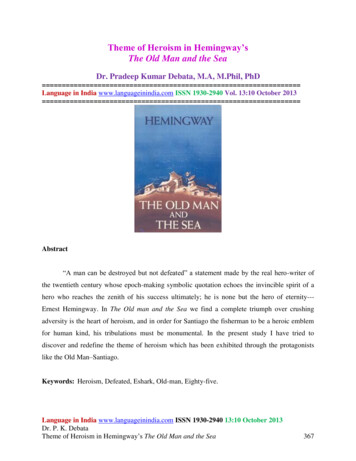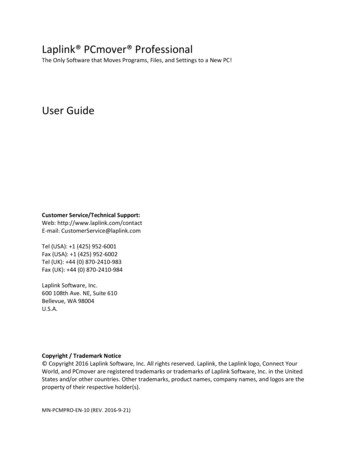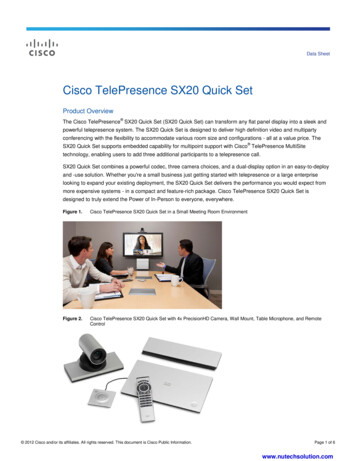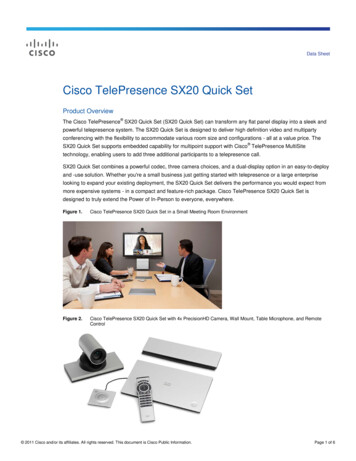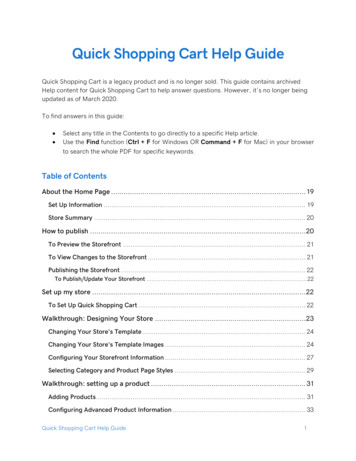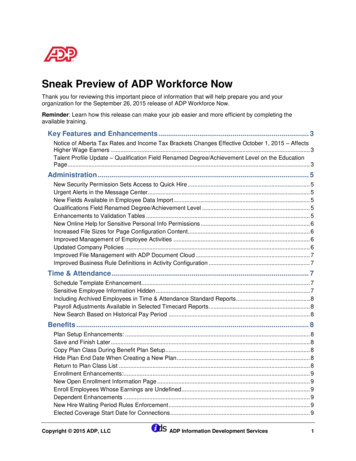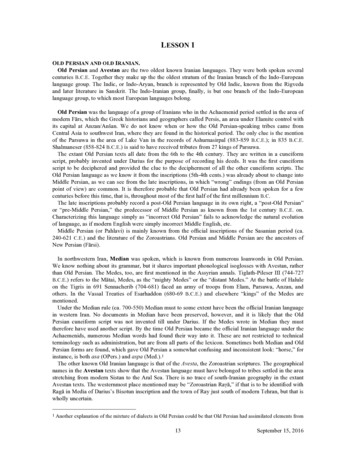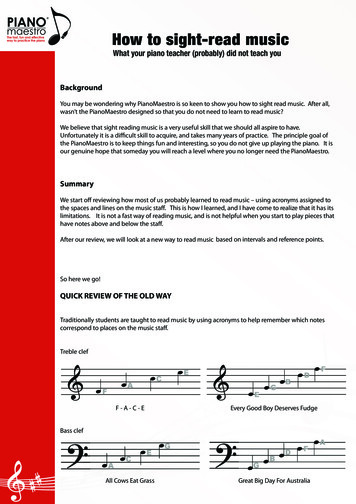
Transcription
How to sight-read musicWhat your piano teacher (probably) did not teach youBackgroundYou may be wondering why PianoMaestro is so keen to show you how to sight read music. After all,wasn’t the PianoMaestro designed so that you do not need to learn to read music?We believe that sight reading music is a very useful skill that we should all aspire to have.Unfortunately it is a difficult skill to acquire, and takes many years of practice. The principle goal ofthe PianoMaestro is to keep things fun and interesting, so you do not give up playing the piano. It isour genuine hope that someday you will reach a level where you no longer need the PianoMaestro.SummaryWe start off reviewing how most of us probably learned to read music – using acronyms assigned tothe spaces and lines on the music staff. This is how I learned, and I have come to realize that it has itslimitations. It is not a fast way of reading music, and is not helpful when you start to play pieces thathave notes above and below the staff.After our review, we will look at a new way to read music based on intervals and reference points.So here we go!QUICK REVIEW OF THE OLD WAYTraditionally students are taught to read music by using acronyms to help remember which notescorrespond to places on the music staff.Treble clefF-A-C-EEvery Good Boy Deserves FudgeAll Cows Eat GrassGreat Big Day For AustraliaBass clef
THE NEW WAY OF READING MUSICThe new way to read music requires some initial investment, but trust me, it is well worth it.This method comprises of three steps:1. learn the intervals2. memorize reference points3. combine 1 and 2STEP 1: Learn the intervalsThere are 5 intervals to learn.a. “Same”Notes that are on the same line or on the same space represent the same note. Therefore, you do notneed to move your finger position to play it.b. “Up one or down one”Up oneDown oneUp oneDown oneUp oneUp oneDown oneDown one“Up or down one” is represented by two notes where one is on a line and the other is on a space.There are four finger combinations per hand.Up oneUp oneUp oneUp oneFor “up one”, play the lower note first (ie the one further to the left) followed by the higher note. For“down one”, play the higher note first (ie the one further to the right)
c. “up or down a jump”Up a jumpUp a jumpDown a jumpDown a jumpUp a jumpDown a jumpUp a jumpDown a jumpUp or down a jump represents two notes that are separated by a line or a space. There are three fingercombinations per hand.d. “up or down a fourth”Up a fourthDown a fourthUp a fourthDown a fourthUp a fourthUp a fourthDown a fourthDown a fourth“Up or down a fourth” represents two notes that are separated by a line and a space. This is thestrangest looking interval that you will encounter while reading sheet music. The note will start ona line and end on a space. Or the note will start on a space and end on a line. If you find yourselfhesitating, we suggest that you play a fourth by default. More often than not, you will be right!There are two finger combinations per hand to play this interval.
e. “up or down a double jump”Up a double jumpUp a double jumpUp a double jumpDown a double jumpDown a double jumpDown a double jumpUp a double jumpDown a double jump“Up or down a double jump” represents two notes that are separated by two lines and a space or twospaces and a line.There is one way per hand to play this interval.We have just finished covering the topic of intervals. Now we can move to step 2 : Reference points
Step 2 : Reference PointThe second step is to memorize certain notes on each staff. We will cover the five C’s, but they canbe any notes. The key is that you should be able to identify and locate these notes automatically.This takes practice, but the rewards are hugeIt is worth noting that “middle C” is not drawn in the middle of the two staffs. Also, the high and lowC’s can take some time to remember. We were told to think of it as a “hamburger on a plate”.In these materials we suggest remembering the 5 C’s. However, it is helpful if you can recognize othernotes as well. For example, I can quickly identify the B in the treble clef and the D in the bass clef (theyare easy to remember because they are in the middle of the staffs). The more reference points youhave, the easier it will be to sight read music.
Step 3 : Putting it all TogetherAt this point you should be comfortable with the different intervals and the 5 C’s. If you are not totallyconfident, go back and review to STEP 1 and STEP 2.To figure out where a note is on a piece of sheet music, figure out where it is relative to one of the 5 C’sor the note before it.The following 8 examples illustrate how to systematically figure out the notes of an unfamiliar piece.Please note that we are not figuring out what each note is (ie first C, then B, then D). It is all relative tothe reference notes.1Middle C1DoublejumpbelowMiddle C2Up a jumpfromMiddle C3Same aspreviousnote23Up a jumpfromMiddle CUp a jumpfromtreble C4567Up adoublejump frompreviousnote ordownone fromtreble CUp a jumpfrompreviousnote or upone fromtreble CDown adoublejump frompreviousnote ordown afourthfromtreble CDownone frompreviousnote or upa fourthfrommiddle C45678Down ajump fromtreble CDownone frompreviousnote or upa doublejump fromMiddle CHigh CDown adoublejumpfrom highC or upa fourthfromtreble CUp onefrompreviousnote8Treble C
1Downone fromtreble C2Up afourthfrompreviousnote ora jumpup fromtreble C12Down ajump fromtreble CUp adoublejump frompreviousnote orup a jumpfromtreble C3Treble C3High C4Doublejumpdownfromtreble C ora fourthup fromMiddle C4Down afourthfrom highC or upa doublejump fromTreble CThe same technique can be used for the bass clef.5Up onefrompreviousnote ora doublejumpup fromMiddle C5Up onefrompreviousnote ora doublejumpup fromMiddle C6Jumpup fromtreble C6Downone fromtreble C7Up afourthfrompreviousnote ordown ajump fromhigh C8Treble C78Downone frompreviousnote ordown ajump fromtreble CDown adoublejump frompreviousnote or upone fromMiddle C
1Jumpabovelow C2Up a jumpfrom LowC3Same aspreviousnote45678Up adoublejump frompreviousnote or upone frombass CUp a jumpfrompreviousnote or upa fourthfrom bassCDown adoublejump frompreviousnote ordown onefrom bassCDownone frompreviousnote ordown ajump frombass CUp a jumpfrom bassC12345Down ajump fromlow CUp adoublejump fromlow CUp adoublejump frombass CUp a jumpfromMiddle CDown ajump fromMiddle C1Up onefrom bassC2Up afourthfrompreviousnote ordown afourthfromMiddle C34Up a jumpfrom BassCDoublejumpdownfrompreviousnote ordown ajump fromBass C5Up onefrompreviousnote ora downone fromBass C6Up onefrompreviousnote ordownone fromMiddle C6Down afourthfromMiddle C7Bass C7Middle C8Down onefrom bassC8Jump upfrom BassC
1Bass C2Up adoublejump fromBass C ora fourthdownfromMiddle C3Jumpup fromMiddle C4Down afourthfrompreviousnote ordownone fromMiddle C5Up onefrom BassC6Bass C7Down onefrom BassC8Down afourthfrompreviousnote ordoublejumpbelowBass CConclusionWe hope that you find this new method of learning to read music as helpful as we did. By readingintervals (instead of mapping from an acronym), you will find yourself able to follow the shape of themusic across the music score. Because you have solid reference points over 5 octaves (the 5 C’s), youwill never be lost – even the most difficult pieces. Keep practicing – the rewards are huge for thosewho endure. And if you need a little help, consider using the PianoMaestro.
the PianoMaestro is to keep things fun and interesting, so you do not give up playing the piano. It is our genuine hope that someday you will reach a level where you no longer need the PianoMaestro. Summary We start off reviewing how most of us probably learned to read music – using acro
